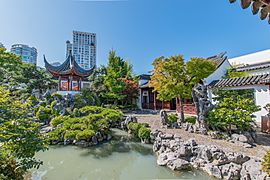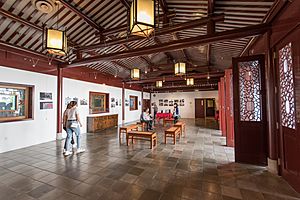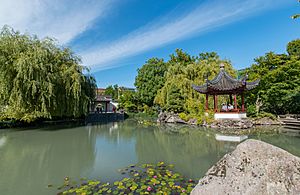Dr. Sun Yat-Sen Classical Chinese Garden facts for kids
Quick facts for kids Dr. Sun Yat-Sen Classical Chinese Garden |
|
|---|---|
 |
|
| Type | Non-profit charity |
| Location | 578 Carrall Street Vancouver, British Columbia V6B 5K2 |
| Area | 0.3 acres (0.12 ha) |
| Created | 1986 |
The Dr. Sun Yat-Sen Classical Chinese Garden is a beautiful and peaceful place in Vancouver, British Columbia, Canada. It's special because it was the first traditional Chinese "scholars' garden" built outside of China. You can find it in Vancouver's lively Chinatown area.
The garden has two parts: a public park that anyone can visit for free, and a special garden area that requires an admission fee. The main goal of the garden is to help people understand and appreciate Chinese culture. It also aims to connect Chinese and Western cultures and be an important part of the local community.
Contents
Discovering the Dr. Sun Yat-Sen Garden
How the Garden Was Built
This amazing garden was built between 1985 and 1986. The public park area was designed by talented architects Joe Wai and Donald Vaughan. The inner, more detailed garden was imagined by Wang Zu-Xin. He was the main architect, and he got help from experts from Suzhou, China. Suzhou is famous for its classical gardens.
Money for the project came from many places. Both the Chinese and Canadian governments helped. The local Chinese community also gave a lot of support. Other groups and private donors contributed too. The garden officially opened on April 24, 1986, just in time for Expo 86, a big world fair held in Vancouver.
Plants and Seasons in the Garden
Vancouver's winter weather is quite similar to Suzhou's. This means many of the same types of plants found in Suzhou gardens also grow well here. The plants were carefully chosen to show off the different seasons. They especially highlight the "awakening" of spring.
Each plant also has a special meaning. They might represent something symbolic, historical, or from Chinese stories. Unlike Western gardens, plants are used sparingly here. This allows each plant to stand out and add color throughout the year.
Philosophy and Design of the Garden
Classical Chinese gardens are designed using ideas from Chinese philosophy, like Feng shui and Taoism. These ideas focus on creating harmony and balance. For example, rough, craggy rocks are placed next to delicate plants. This creates a beautiful contrast.
Water is also a very important part of the garden. The large pond is calm and reflects the sky. It also adds sounds and helps connect all the different parts of the garden. You might see fish and turtles living in the pond. They also have special meanings in Chinese culture.
Throughout the garden, you'll find symbols of animals like Bats, dragons, and phoenixes. These are often seen in objects or decorations. Many large rocks are placed in specific spots. They are meant to look like mountains, hiding and then revealing different parts of the park as you walk around.
Who Was Dr. Sun Yat-Sen?
The garden is named after Dr. Sun Yat-Sen. He was a very important leader in China. Many people call him the "father of modern China." He worked to create a new, modern China.
Dr. Sun Yat-Sen had a special connection to Vancouver. He traveled all over the world to get support and money for the Chinese nationalist movement. He visited Vancouver three times and stayed for long periods. At that time, many Chinese nationalists lived in British Columbia. They helped fund the Xinhai Revolution. This revolution overthrew the Qing Dynasty in 1911. After the revolution, Sun Yat-Sen became the first president of the Republic of China.
Garden vs. Park: What's the Difference?
It's good to know that the Dr. Sun Yat-Sen Park and the Dr. Sun Yat-Sen Classical Chinese Garden are two different places. They are connected by an artificial pond. The Classical Chinese Garden is the special, detailed garden we've been talking about. The Dr. Sun Yat-Sen Park is a public park. It's also built in a Chinese style, but it mostly uses materials found in North America.



